Kinematic Strategies for Sustainable Well-Being in Aging Adults Influenced by Footwear and Ground Surface
Abstract
1. Introduction
2. Methodology
2.1. Age Simulation Suit
2.2. Subjects
2.3. Footwear and Ground Surface
2.4. Experimental Protocol
2.5. Data Analysis
3. Results
3.1. ROM in the Sagittal Plane
3.2. ROM in the Coronal Plane
3.3. ROM in the Transverse Plane
3.4. Subjective Evaluation of Stability
4. Discussion
4.1. Effects of Footwear and Ground Surface on ROM
4.2. Effect of Footwear toe Spring and Rocker Sole Design on Kinematic Strategies
4.3. Recommendations for Kinematic Control Strategies for Aging Adults
5. Limitations
6. Conclusions
Author Contributions
Funding
Institutional Review Board Statement
Informed Consent Statement
Data Availability Statement
Conflicts of Interest
References
- Gates, D.H.; Wilken, J.M.; Scott, S.J.; Sinitski, E.H.; Dingwell, J.B. Kinematic strategies for walking across a destabilizing rock surface. Gait Posture 2012, 35, 36–42. [Google Scholar] [CrossRef]
- Hausdorff, J.M.; Rios, D.A.; Edelberg, H.K. Gait variability and fall risk in community-living older adults: A 1-year prospective study. Arch. Phys. Med. Rehabil. 2001, 82, 1050–1056. [Google Scholar] [CrossRef]
- Swanenburg, J.; de Bruin, E.D.; Uebelhart, D.; Mulder, T. Falls prediction in elderly people: A 1-year prospective study. Gait Posture 2009, 31, 317–321. [Google Scholar] [CrossRef]
- Dixon, P.C.; Schütte, K.H.; Vanwanseele, B.; Jacobs, J.V.; Dennerlein, J.T.; Schiffman, J.M. Gait adaptations of older adults on an uneven brick surface can be predicted by age-related physiological changes in strength. Gait Posture 2018, 61, 61257–61262. [Google Scholar] [CrossRef]
- Li, W.; Keegan, T.; Sternfeld, B.; Sidney, S.; Quesenberry, C.P.; Kelsey, J.L. Outdoor Falls among Middle-Aged and Older Adults: A Neglected Public Health Problem. Am. J. Public Health 2006, 96, 1192–1200. [Google Scholar] [CrossRef]
- Stoesz, B.; Chimney, K.; Deng, C.; Grogan, H.; Menec, V.; Piotrowski, C.; Shooshtari, S.; Turner, N. Incidence, risk factors, and outcomes of non-fatal work-related injuries among older workers: A review of research from 2010 to 2019. Safety Sci. 2020, 126, 104668. [Google Scholar] [CrossRef]
- Du, X.; Chen, Y.; Bouferguene, A.; Al-Hussein, M. An agent-based simulation framework for analysing fall risk among older adults in the evacuation procedures—ScienceDirect. Safety Sci. 2020, 129, 104790. [Google Scholar] [CrossRef]
- Rubenstein, L.Z. Falls in older people: Epidemiology, risk factors and strategies for prevention. Age Ageing 2006, 35, i37–i41. [Google Scholar] [CrossRef] [PubMed]
- Marigold, D.S.; Patla, A.E. Age-related changes in gait for multi-surface terrain. Gait Posture 2008, 27, 689–696. [Google Scholar] [CrossRef] [PubMed]
- Menant, J.C.; Steele, J.R.; Menz, H.B.; Munro, B.J.; Lord, S.R. Effects of walking surfaces and footwear on temporo-spatial gait parameters in young and older people. Gait Posture 2008, 29, 392–397. [Google Scholar] [CrossRef]
- Zurales, K.; Demott, T.K.; Kim, H.; Allet, L.; Ashton-Miller, J.A.; Richardson, J.K. Gait Efficiency on an Uneven Surface Is Associated with Falls and Injury in Older Subjects with a Spectrum of Lower Limb Neuromuscular Function: A Prospective Study. Am. J. Phys. Med. Rehab. 2016, 95, 83–90. [Google Scholar] [CrossRef]
- Lord, S.R.; Ward, J.A.; Williams, P.; Anstey, K.J. An epidemiological study of falls in older community-dwelling women: The Randwick falls and fractures study. Aust. J. Public Health. 1993, 17, 240–245. [Google Scholar] [CrossRef]
- Menant, J.C.B.; Perry, S.D.P.; Steele, J.R.P.; Menz, H.B.P.; Munro, B.J.P.; Lord, S.R.P.D. Effects of Shoe Characteristics on Dynamic Stability When Walking on Even and Uneven Surfaces in Young and Older People. Arch. Phys. Med. Rehab. 2008, 89, 1970–1976. [Google Scholar] [CrossRef]
- Menz, H.B.; Lord, S.R.; Fitzpatrick, R.C. Age-related differences in walking stability. Age Ageing 2003, 32, 137–142. [Google Scholar] [CrossRef]
- Tencer, A.F.; Koepsell, T.D.; Wolf, M.E.; Frankenfeld, C.L.; Buchner, D.M.; Kukull, W.A.; Lacroix, A.Z.; Larson, E.B.; Tautvydas, M. Biomechanical properties of shoes and risk of falls in older adults. J. Am. Geriatr. Soc. 2004, 52, 1840–1846. [Google Scholar] [CrossRef]
- Thies, S.B.; Richardson, J.K.; Ashton-Miller, J.A. Effects of surface irregularity and lighting on step variability during gait: A study in healthy young and older women. Gait Posture 2005, 22, 26–31. [Google Scholar] [CrossRef]
- Koepsell, T.D.; Wolf, M.E.; Buchner, D.M.; Kukull, W.A.; Lacroix, A.Z.; Tencer, A.F.; Frankenfeld, C.L.; Tautvydas, M.; Larson, E.B. Footwear style and risk of falls in older adults. J. Am. Geriatr. Soc. 2004, 52, 1495–1501. [Google Scholar] [CrossRef]
- Robbins, S.; Waked, E.; Allard, P.; Mcclaran, J.; Krouglicof, N. Foot position awareness in younger and older men: The influence of footwear sole properties. J. Am. Geriatr. Soc. 1997, 45, 61–66. [Google Scholar] [CrossRef]
- Thies, S.B.; Price, C.; Kenney, L.P.; Baker, R. Effects of shoe sole geometry on toe clearance and walking stability in older adults. Gait Posture 2015, 42, 105–109. [Google Scholar] [CrossRef]
- Menant, J.C.; Steele, J.R.; Menz, H.B.; Munro, B.J.; Lord, S.R. Effects of footwear features on balance and stepping in older people. Gerontology 2008, 54, 18–23. [Google Scholar] [CrossRef]
- Arnadottir, S.A.; Mercer, V.S. Effects of footwear on measurements of balance and gait in women between the ages of 65 and 93 years. Phys. Ther. 2000, 80, 17–27. [Google Scholar] [CrossRef]
- Lindemann, U.; Scheible, S.; Sturm, E.; Eichner, B.; Ring, C.; Najafi, B.; Aminian, K.; Nikolaus, T.; Becker, C. Elevated heels and adaptation to new shoes in frail elderly women. Z. Gerontol. Geriatr. 2003, 36, 29–34. [Google Scholar] [CrossRef]
- Robbins, S.; Gouw, G.J.; Mcclaran, J. Shoe Sole Thickness and Hardness Influence Balance in Older Men. J. Am. Geriatr. Soc. 1992, 40, 1089–1094. [Google Scholar] [CrossRef]
- Menz, H.B.; Morris, M.E. Footwear Characteristics and Foot Problems in Older People. Gerontology 2005, 51, 346–351. [Google Scholar] [CrossRef]
- Stacoff, A.; Steger, J.; Stüssi, E.; Reinschmidt, C. Lateral stability in sideward cutting movements. Med. Sci. Sport. Exer. 1996, 28, 350–358. [Google Scholar]
- Nigg, B.; Hintzen, S.; Ferber, R. Effect of an unstable shoe construction on lower extremity gait characteristics. Clin. Biomech. 2006, 21, 82–88. [Google Scholar] [CrossRef]
- Cox, S.; Birch, I.; Otter, S. The effect of Masai Barefoot technology (MBT) shoes on ankle joint complex kinematics and plantar heel pressure distribution. J. Foot Ankle Res. 2010, 3, P4. [Google Scholar] [CrossRef]
- Tian, M.; Park, H.; Li, J.; Koo, H.; Xu, Q. Effects of load carriage and work boots on lower limb kinematics of industrial workers. Int. J. Occup. Saf. Ergon. 2018, 24, 582–591. [Google Scholar] [CrossRef]
- Lauenroth, A.; Schulze, S.; Ioannidis, A.; Simm, A.; Schwesig, R. Effect of an age simulation suit on younger adults’ gait performance compared to older adults’ normal gait. Res. Gerontol. Nurs. 2017, 10, 227–233. [Google Scholar] [CrossRef]
- Karlsson, M.K.; Magnusson, H.; Schewelov, T.V.; Rosengren, B.E. Prevention of falls in the elderly—A review. Osteoporos. Int. 2013, 24, 747–762. [Google Scholar] [CrossRef]
- Tinetti, M.E.; Speechley, M.; Ginter, S.F. Risk factors for falls among elderly persons living in the community. N. Engl. J. Med. 1988, 319, 1701–1707. [Google Scholar] [CrossRef] [PubMed]
- Chiu, M.; Wu, H.; Chang, L. Gait speed and gender effects on center of pressure progression during normal walking. Gait Posture 2012, 37, 43–48. [Google Scholar] [CrossRef] [PubMed]
- Yu, X.; Guan, J.; Luo, Y. Design and Development of Anti-impact Hip Protection Pants for Elderly Female. J. Donghua Univ.(Natur. Sci. Ed.) 2020, 46, 733–739. [Google Scholar]
- Tian, M.; Lei, Y.; Wang, Y.; Li, J.; Zhang, X. Application of age simulation suit for research on gait stability. Text. Res. J. 2021, 42, 144–148. [Google Scholar]
- Likert, R. A technique for the measurement of attitudes. Arch. Psychol. 1932, 22, 44–54. [Google Scholar]
- Lv, X. Study on the Effect of Speed and Shoe Type on Lower Limb Joint Kinematics in Young Women; Ningbo University: Ningbo, China, 2018. [Google Scholar]
- Armand, S.; Tavcar, Z.; Turcot, K.; Allet, L.; Hoffmeyer, P.; Genevay, S. Effects of unstable shoes on chronic low back pain in health professionals: A randomized controlled trial. Jt. Bone Spine 2014, 81, 527–532. [Google Scholar] [CrossRef]
- Bochdansky, T.; Maetzler, M.; Laube, W. Pressure distribution and muscular activity on treadmill–downhill running with an unstable shoe construction and normal running shoes. Clin. Biomech. 2008, 23, 664–665. [Google Scholar] [CrossRef]
- Robbins, S.; Waked, E.; Mcclaran, J. Proprioception and stability: Foot position awareness as a function of age and footwear. Age Ageing 1995, 24, 67–72. [Google Scholar] [CrossRef]
- Dubin, J.C.; Comeau, D.; Mcclelland, R.I.; Dubin, R.A.; Ferrel, E. Lateral and syndesmotic ankle sprain injuries: A narrative literature review. J. Chiropr. Med. 2011, 10, 204–219. [Google Scholar] [CrossRef]
- Menz, H.B.; Lord, S.R. Footwear and postural stability in older people. J. Am. Podiat. Med. Assn. 1999, 89, 346–357. [Google Scholar] [CrossRef]
- Chapman, J.D.; Preece, S.; Braunstein, B.; Höhne, A.; Nester, C.J.; Brueggemann, P.; Hutchins, S. Effect of rocker shoe design features on forefoot plantar pressures in people with and without diabetes. Clin. Biomech. 2013, 28, 679–685. [Google Scholar] [CrossRef] [PubMed]
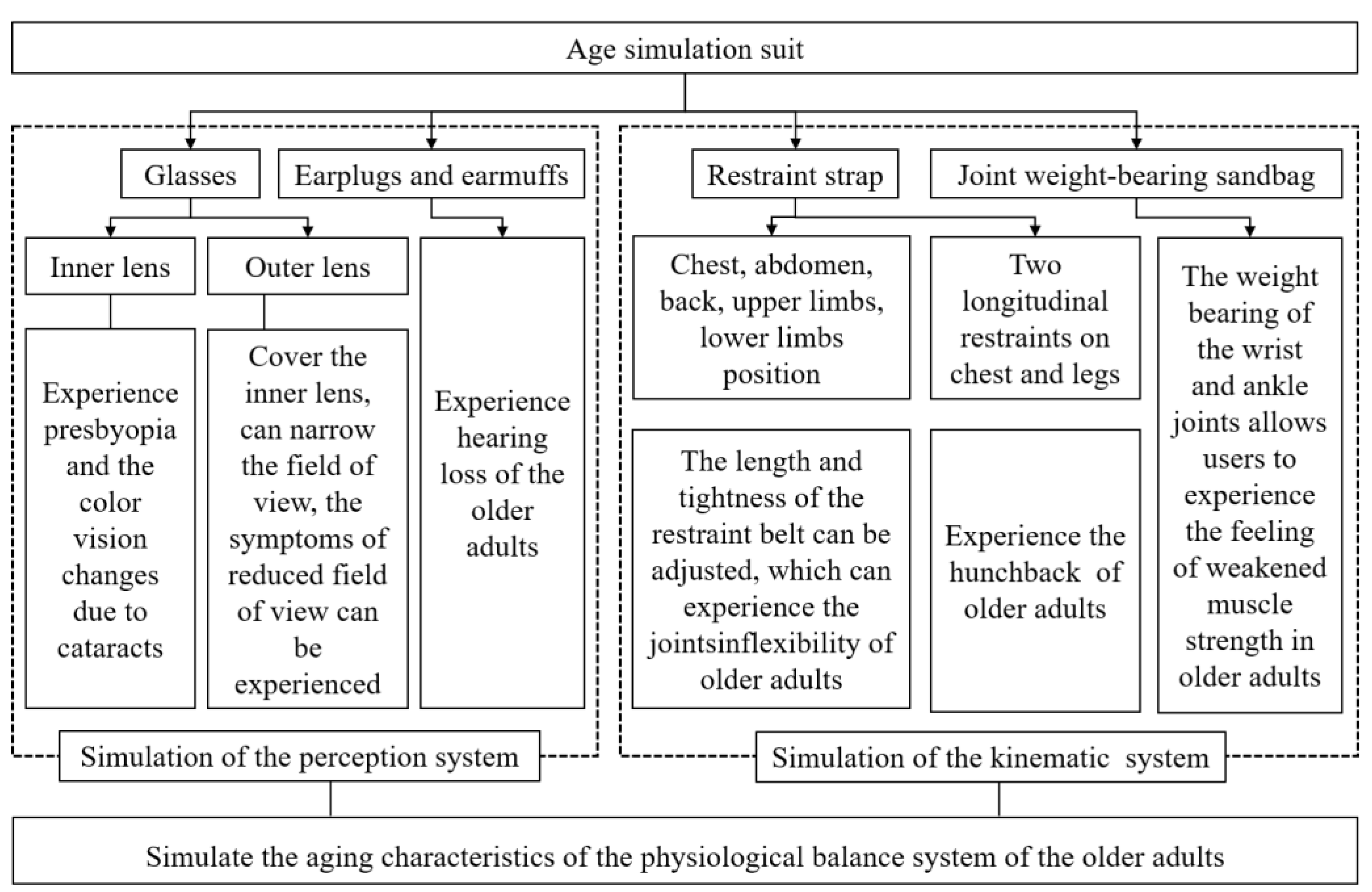
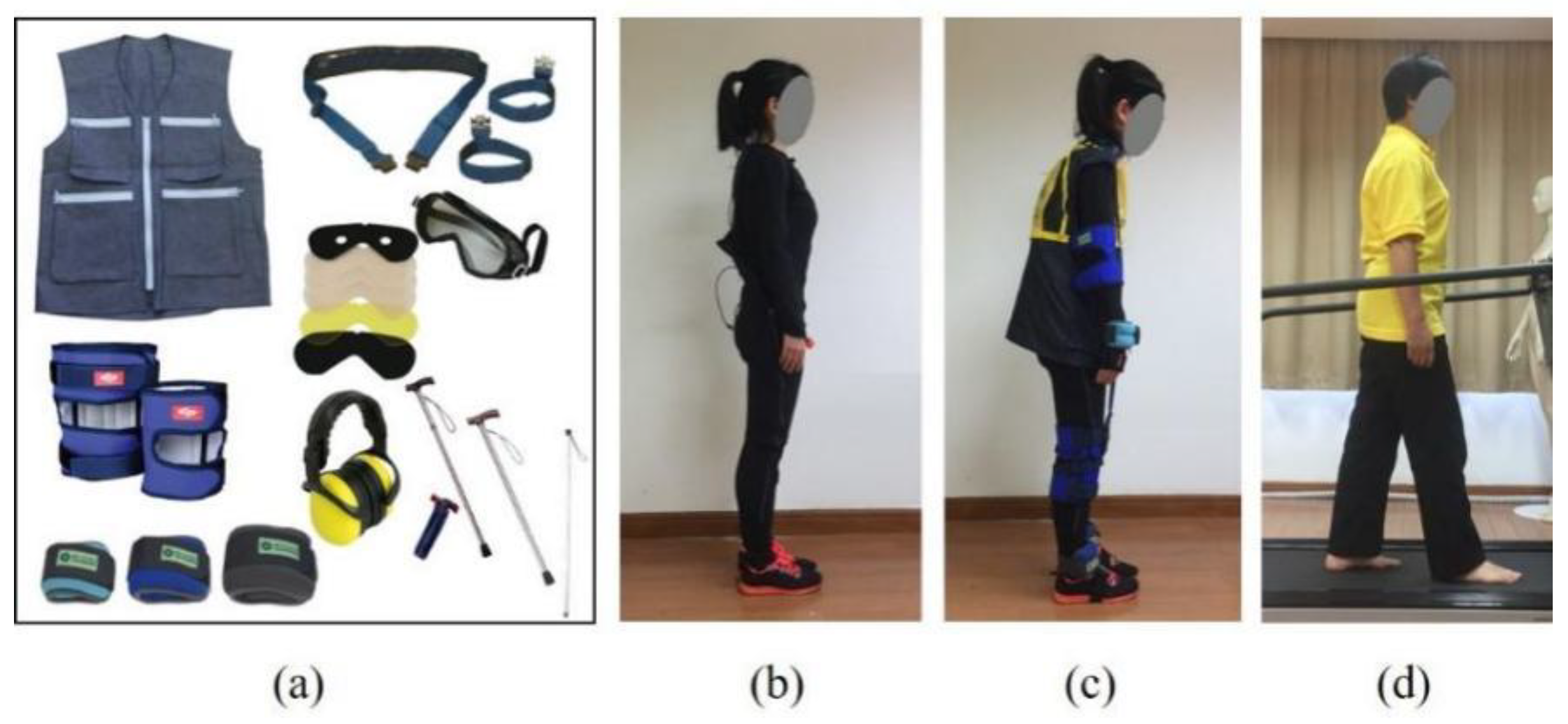

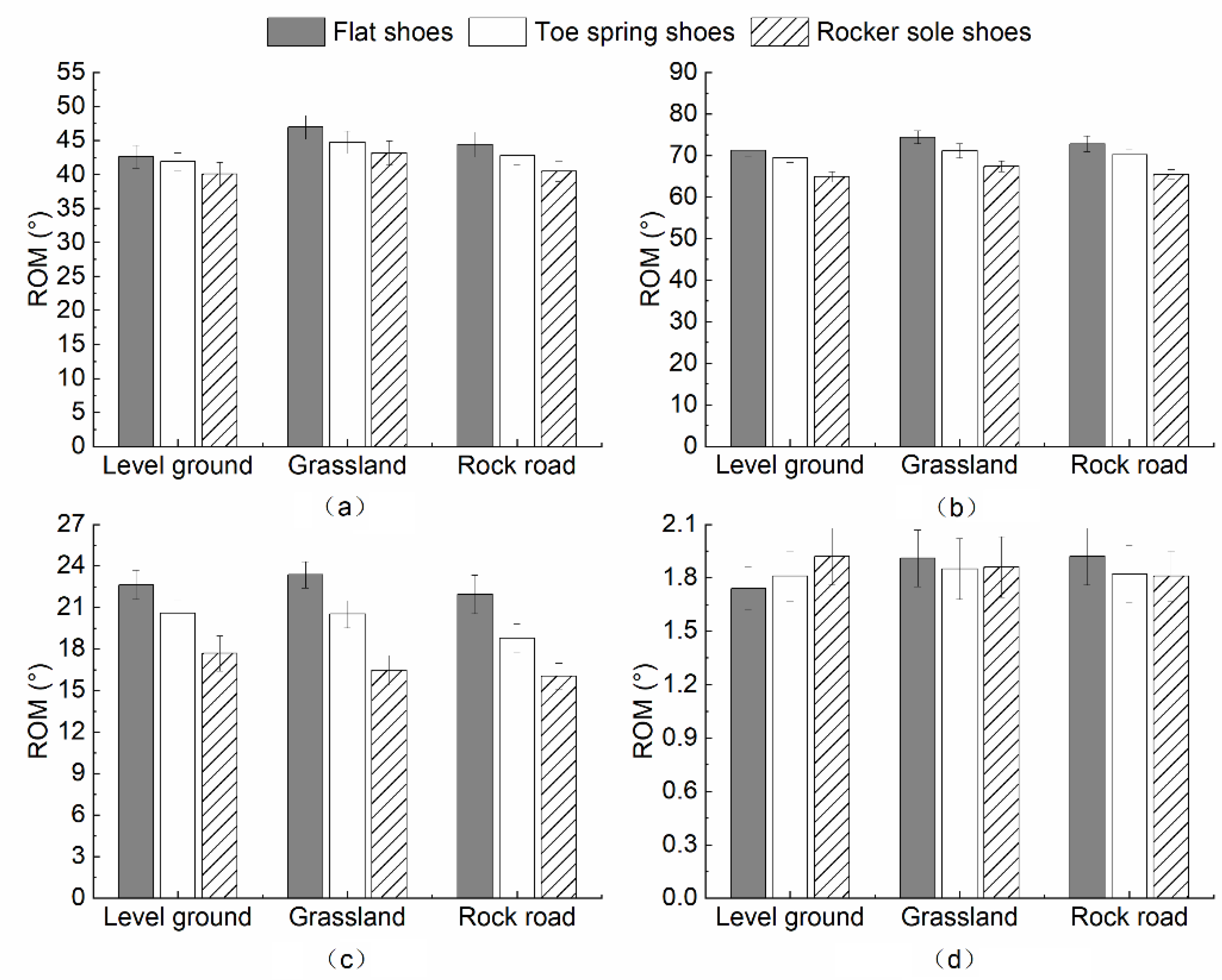
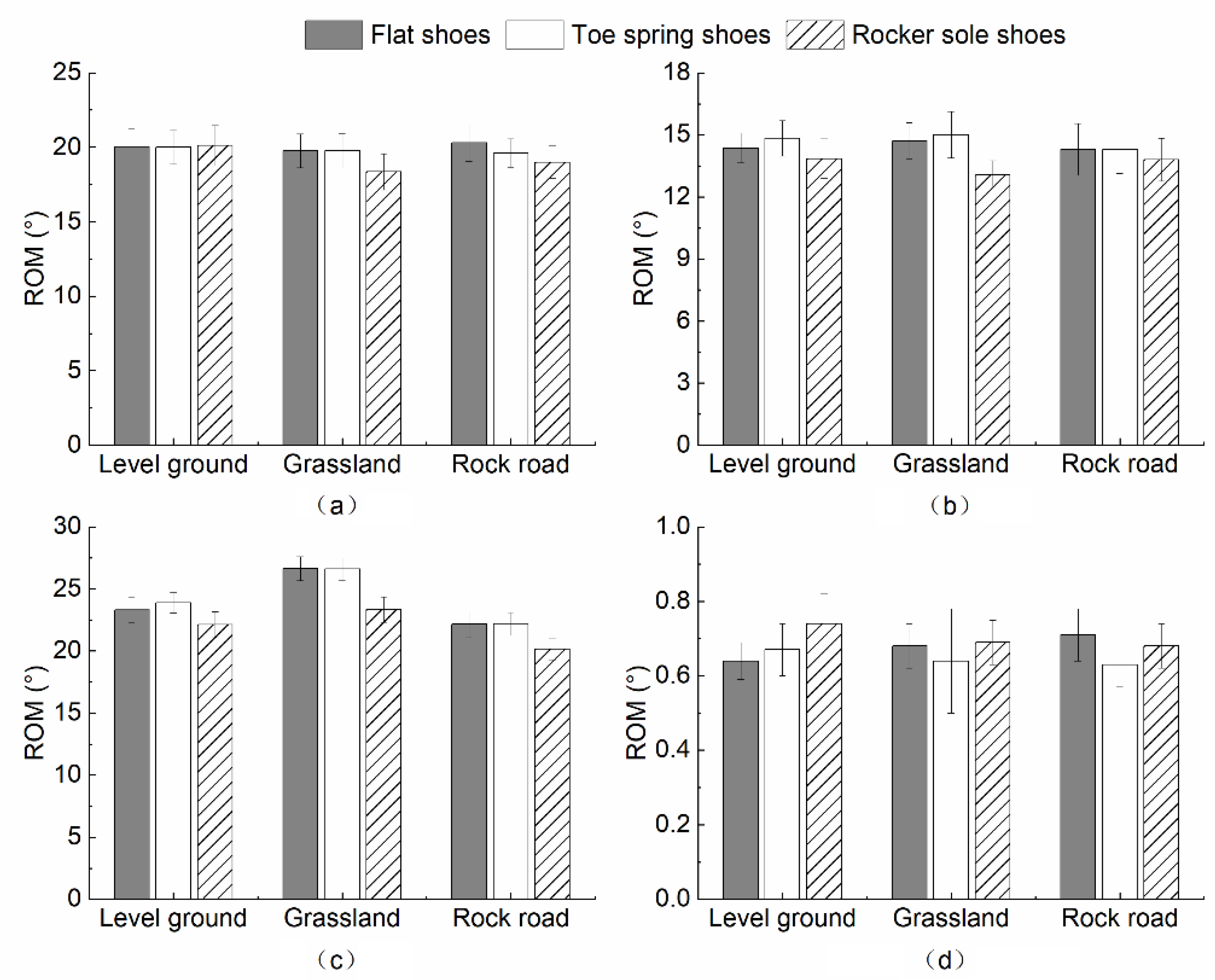
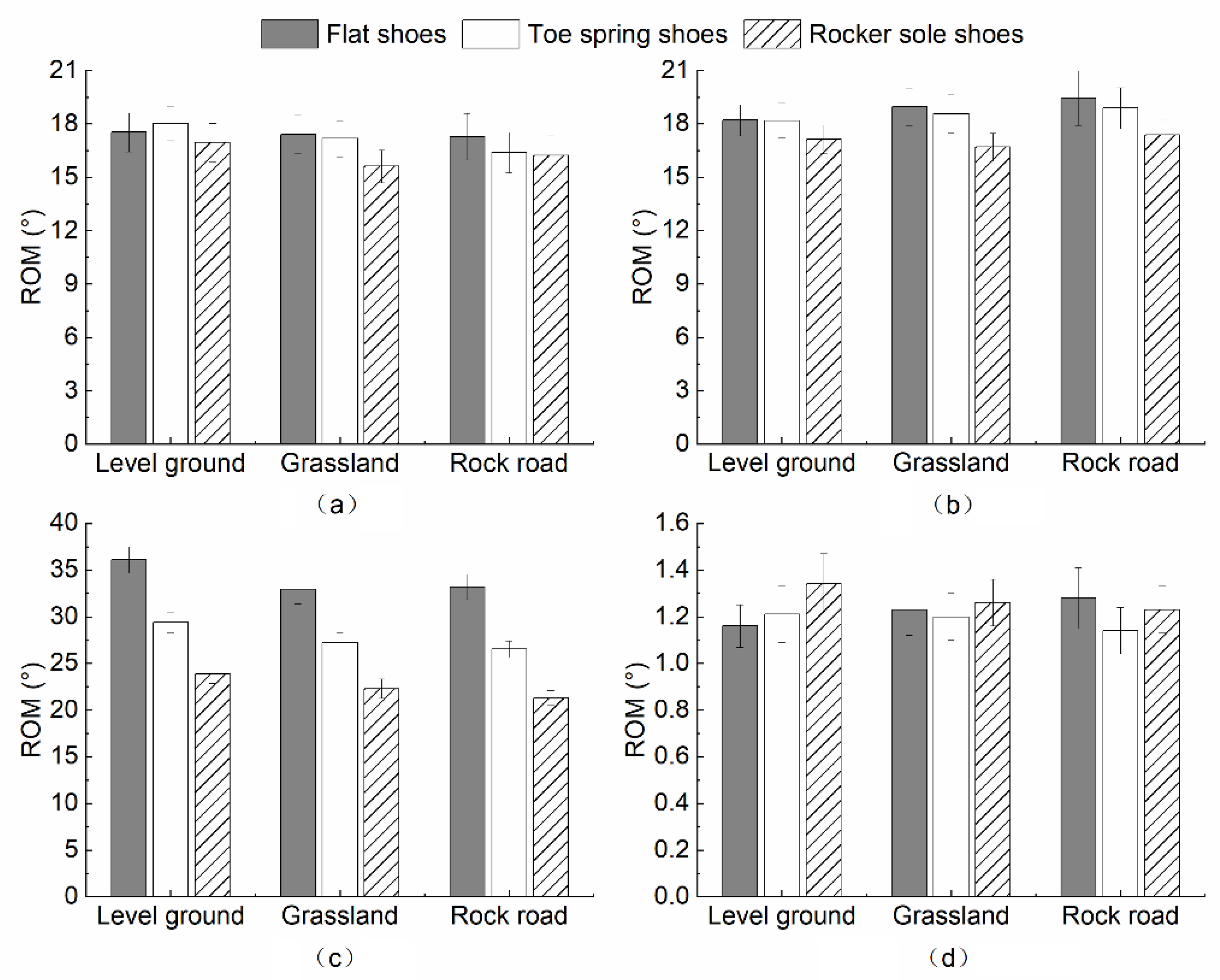

| Footwear | Side View | Sole Geometry | Sole Texture | Shoe Closure | Sole Material | |
|---|---|---|---|---|---|---|
| The flat shoes |  | Flat sole | Horizontal stripes |  | Shoelace | Rubber |
| The toe spring shoes |  | Toe spring | Horizontal twill |  | Velcro | Rubber |
| The rocker sole shoe |  | Rocker sole | Horizontal stripes |  | Velcro | Rubber |
| Ground Surface | Joint | ROM (°) | Flat Shoes | Toe Spring Shoes | Rocker Sole Shoes | Results of MANOVA | |||
|---|---|---|---|---|---|---|---|---|---|
| Statistical Quantity (F) | Degree of Freedom (df) | Significance (p) | |||||||
| Level ground | Hip | Est. M | 42.60 | 41.89 | 40.09 | 0.688 | 2 | 39 | 0.508 |
| 6.16 | 4.82 | 6.41 | |||||||
| Knee | Est. M | 71.28 | 69.44 | 64.88 | 6.694 | 2 | 39 | 0.003 * | |
| 5.39 | 4.13 | 4.68 | |||||||
| Ankle | Est. M | 22.63 | 20.58 | 17.68 | 5.046 | 2 | 39 | 0.011 * | |
| 3.89 | 3.72 | 4.75 | |||||||
| Ball of the foot | Est. M | 1.74 | 1.81 | 1.92 | 0.384 | 2 | 39 | 0.684 | |
| 0.45 | 0.54 | 0.60 | |||||||
| Grassland | Hip | Est. M | 46.95 | 44.76 | 43.15 | 1.233 | 2 | 39 | 0.302 |
| 6.52 | 6.15 | 6.57 | |||||||
| Knee | Est. M | 74.42 | 71.16 | 67.42 | 5.264 | 2 | 39 | 0.009 * | |
| 5.74 | 6.40 | 4.90 | |||||||
| Ankle | Est. M | 23.35 | 20.52 | 16.46 | 12.123 | 2 | 39 | <0.001 * | |
| 3.53 | 3.68 | 3.95 | |||||||
| Ball of the foot | Est. M | 1.91 | 1.85 | 1.86 | 0.040 | 2 | 39 | 0.961 | |
| 0.60 | 0.62 | 0.62 | |||||||
| Rock road | Hip | Est. M | 44.42 | 42.78 | 40.44 | 1.590 | 2 | 39 | 0.217 |
| 6.84 | 5.13 | 5.70 | |||||||
| Knee | Est. M | 72.78 | 70.21 | 65.49 | 5.994 | 2 | 39 | 0.005 * | |
| 7.07 | 5.15 | 4.38 | |||||||
| Ankle | Est. M | 21.94 | 18.77 | 16.04 | 6.769 | 2 | 39 | 0.003 * | |
| 5.16 | 3.92 | 3.46 | |||||||
| Ball of the foot | Est. M | 1.92 | 1.82 | 1.81 | 0.151 | 2 | 39 | 0.860 | |
| 0.61 | 0.58 | 0.51 | |||||||
| Ground Surface | Joint | ROM (°) | Flat Shoes | Toe Spring Shoes | Rocker Sole Shoes | Results of MANOVA | |||
|---|---|---|---|---|---|---|---|---|---|
| Statistical Quantity (F) | Degree of Freedom (df) | Significance (p) | |||||||
| Level ground | Hip | Est. M | 20.02 | 20.01 | 20.12 | 0.002 | 2 | 39 | 0.998 |
| 4.59 | 4.28 | 5.07 | |||||||
| Knee | Est. M | 14.37 | 14.84 | 13.85 | 0.335 | 2 | 39 | 0.717 | |
| 2.69 | 3.20 | 3.61 | |||||||
| Ankle | Est. M | 23.31 | 23.88 | 22.13 | 0.848 | 2 | 39 | 0.436 | |
| 3.88 | 3.13 | 3.87 | |||||||
| Ball of the foot | Est. M | 0.64 | 0.67 | 0.74 | 0.559 | 2 | 39 | 0.576 | |
| 0.20 | 0.27 | 0.29 | |||||||
| Grassland | Hip | Est. M | 19.76 | 19.76 | 18.35 | 0.486 | 2 | 39 | 0.619 |
| 4.23 | 4.36 | 4.49 | |||||||
| Knee | Est. M | 14.71 | 15.00 | 13.08 | 1.310 | 2 | 39 | 0.281 | |
| 3.25 | 4.20 | 2.52 | |||||||
| Ankle | Est. M | 26.63 | 26.59 | 23.33 | 3.828 | 2 | 39 | 0.030 * | |
| 3.65 | 3.40 | 3.80 | |||||||
| Ball of the foot | Est. M | 0.68 | 0.78 | 0.69 | 0.349 | 2 | 39 | 0.707 | |
| 0.24 | 0.51 | 0.23 | |||||||
| Rock road | Hip | Est. M | 20.30 | 19.62 | 19.00 | 0.346 | 2 | 39 | 0.710 |
| 4.65 | 3.60 | 4.06 | |||||||
| Knee | Est. M | 14.29 | 14.29 | 13.80 | 0.061 | 2 | 39 | 0.941 | |
| 4.66 | 4.29 | 3.87 | |||||||
| Ankle | Est. M | 22.15 | 22.18 | 20.17 | 1.478 | 2 | 39 | 0.241 | |
| 3.92 | 3.36 | 3.32 | |||||||
| Ball of the foot | Est. M | 0.71 | 0.63 | 0.68 | 0.371 | 2 | 39 | 0.692 | |
| 0.27 | 0.22 | 0.22 | |||||||
| Ground Surface | Joint | ROM/° | Flat Shoes | Toe Spring Shoes | Rocker Sole Shoes | Results of MANOVA | |||
|---|---|---|---|---|---|---|---|---|---|
| Statistical Quantity (F) | Degree of Freedom (df) | Significance (p) | |||||||
| Level ground | Hip | Est. M | 17.52 | 18.04 | 16.95 | 0.266 | 2 | 39 | 0.768 |
| 4.07 | 3.70 | 4.05 | |||||||
| Knee | Est. M | 18.21 | 18.19 | 17.13 | 0.490 | 2 | 39 | 0.616 | |
| 3.25 | 361 | 3.03 | |||||||
| Ankle | Est. M | 36.08 | 29.38 | 23.84 | 6.628 | 2 | 39 | <0.001 * | |
| 5.26 | 4.21 | 3.73 | |||||||
| Ball of the foot | Est. M | 1.16 | 1.21 | 1.34 | 0.658 | 2 | 39 | 0.523 | |
| 0.34 | 0.44 | 0.50 | |||||||
| Grassland | Hip | Est. M | 17.41 | 17.17 | 15.62 | 0.936 | 2 | 39 | 0.401 |
| 4.02 | 3.82 | 3.43 | |||||||
| Knee | Est. M | 18.96 | 18.56 | 16.70 | 1.514 | 2 | 39 | 0.233 | |
| 3.91 | 4.03 | 2.96 | |||||||
| Ankle | Est. M | 32.95 | 27.21 | 22.30 | 18.618 | 2 | 39 | <0.001 * | |
| 5.86 | 3.92 | 3.80 | |||||||
| Ball of the foot | Est. M | 1.23 | 1.20 | 1.26 | 0.103 | 2 | 39 | 0.902 | |
| 0.40 | 0.36 | 0.39 | |||||||
| Rock road | Hip | Est. M | 17.28 | 16.39 | 16.23 | 0.230 | 2 | 39 | 0.796 |
| 4.86 | 4.28 | 4.08 | |||||||
| Knee | Est. M | 19.44 | 18.88 | 17.39 | 0.759 | 2 | 39 | 0.475 | |
| 5.72 | 4.30 | 3.30 | |||||||
| Ankle | Est. M | 33.19 | 26.52 | 21.30 | 33.160 | 2 | 39 | <0.001 * | |
| 5.00 | 3.29 | 3.03 | |||||||
| Ball of the foot | Est. M | 1.28 | 1.14 | 1.23 | 0.411 | 2 | 39 | 0.666 | |
| 0.47 | 0.39 | 0.37 | |||||||
| Movement Parameters | Correlation Coefficient | Significance of the Correlation Coefficient (p) | |
|---|---|---|---|
| Sagittal plane | Hip | 0.111 | 0.677 |
| Knee | 0.222 | 0.404 | |
| Ankle | 0.500 | 0.061 | |
| Ball of the foot | −0.222 | 0.404 | |
| Coronal plane | Hip | 0.222 | 0.404 |
| Knee | 0.444 | 0.095 | |
| Ankle | 0.500 | 0.061 | |
| Ball of the foot | −0.111 | 0.677 | |
| Transverse plane | Hip | 0.611 | 0.022 * |
| Knee | 1 | ||
| Ankle | 0.500 | 0.061 | |
| Ball of the foot | −0.278 | 0.297 | |
Publisher’s Note: MDPI stays neutral with regard to jurisdictional claims in published maps and institutional affiliations. |
© 2022 by the authors. Licensee MDPI, Basel, Switzerland. This article is an open access article distributed under the terms and conditions of the Creative Commons Attribution (CC BY) license (https://creativecommons.org/licenses/by/4.0/).
Share and Cite
Tian, M.; Lei, Y.; Wang, Y.; Wang, S.; Li, J.; Yuan, S. Kinematic Strategies for Sustainable Well-Being in Aging Adults Influenced by Footwear and Ground Surface. Healthcare 2022, 10, 2468. https://doi.org/10.3390/healthcare10122468
Tian M, Lei Y, Wang Y, Wang S, Li J, Yuan S. Kinematic Strategies for Sustainable Well-Being in Aging Adults Influenced by Footwear and Ground Surface. Healthcare. 2022; 10(12):2468. https://doi.org/10.3390/healthcare10122468
Chicago/Turabian StyleTian, Miao, Ye Lei, Yunyi Wang, Shitan Wang, Jun Li, and Shu Yuan. 2022. "Kinematic Strategies for Sustainable Well-Being in Aging Adults Influenced by Footwear and Ground Surface" Healthcare 10, no. 12: 2468. https://doi.org/10.3390/healthcare10122468
APA StyleTian, M., Lei, Y., Wang, Y., Wang, S., Li, J., & Yuan, S. (2022). Kinematic Strategies for Sustainable Well-Being in Aging Adults Influenced by Footwear and Ground Surface. Healthcare, 10(12), 2468. https://doi.org/10.3390/healthcare10122468





